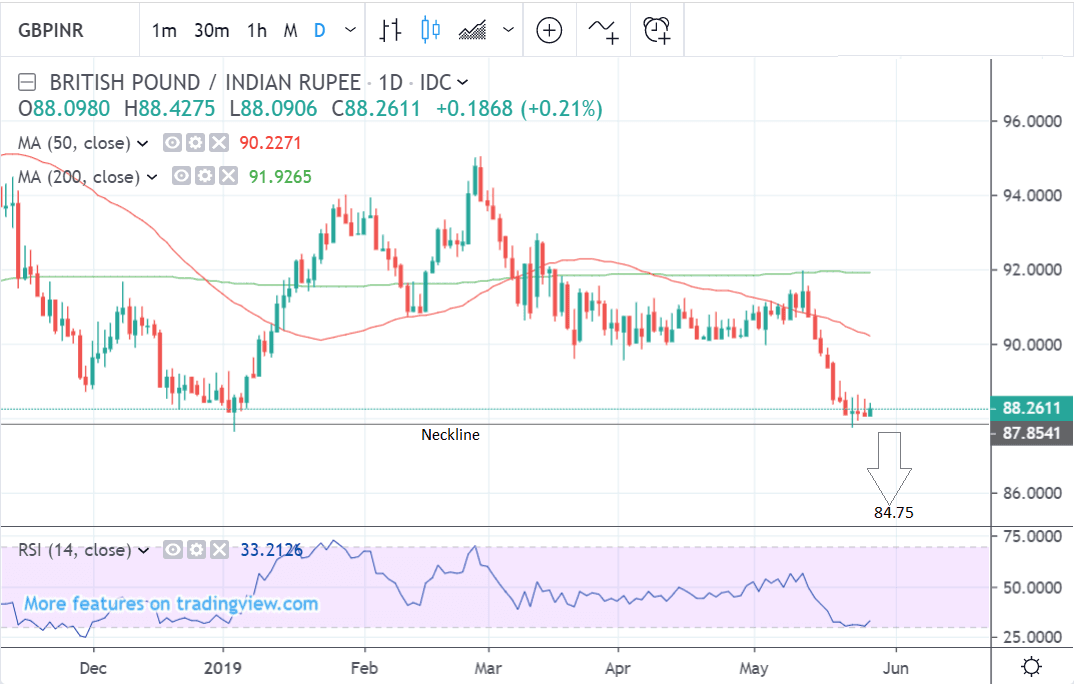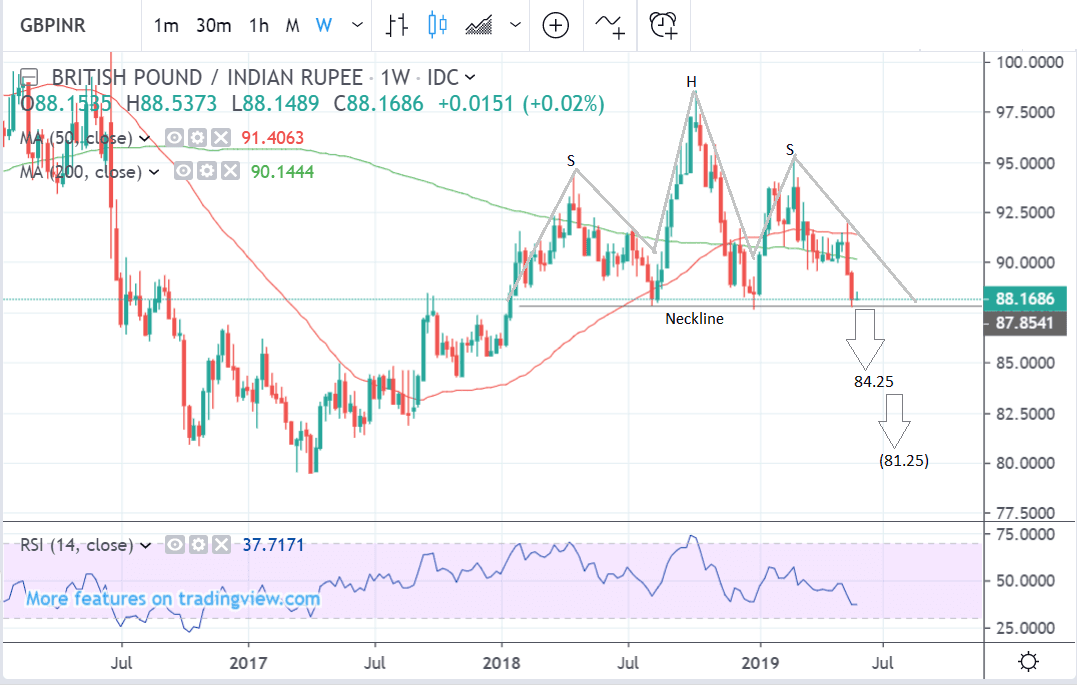Indian Rupee Ready to Make Next Push Against the Pound

Image © Ash T Productions, Adobe Stock
- GBP/INR has formed H&S topping pattern
- Poised at neckline of pattern ready to breakdown
- Risk trends and oil key to Rupee outlook this week
The Pound-to-Rupee exchange rate is trading at 88.23 at the time of writing, up two-tenths of a percent on the day but still inside the sideways range it has been in for most of the last 5 days.
The Indian election and Brexit risks were the main fundamental drivers of the sell-off.
The former ended with the re-election of prime minister Modi and this supported the Rupee; whilst in the UK Brexit risks came to a head with the resignation of prime minister Theresa May. The Pound weakened until the actual news of her departure when it bounced as traders covered their shorts (closed their bearish bets).
There is a risk of further weakness for both GBP/INR and Sterling in general as the risk of a ‘no-deal’ now appears to be greater than before. Whoever replaces May is likely to be a Brexiteer and this means a greater chance of a cliff-edge departure on October 31.
From a technical perspective the support for GBP/INR coincides with the pair finding technical support at 88.00.
The technical outlook remains bearish for Sterling.
GBP/INR is poised to break down to the lower 80s after falling to a key level at the 2019 lows, at 88.00, which is the neckline of a potential bearish head and shoulders (H&S) topping pattern.
A break below the neckline would give the go-ahead for a decline down to a target at roughly 84.25, at the level of the 200-month MA, a key support level for the pair. This could happen within the next two months.
A further decline is also possible to another target at 81.25, based on a percentage of the height of the pattern extrapolated lower. This deeper sell-off might take a lot longer, however, with 3-6 months as a possible time horizon.
A break below the 87.63 January lows would provide confirmation the neckline was broken and the way open for further declines.
Time to move your money? Get 3-5% more currency than your bank would offer by using the services of foreign exchange specialists at RationalFX. A specialist broker can deliver you an exchange rate closer to the real market rate, thereby saving you substantial quantities of currency. Find out more here. * Advertisement
The Rupee: What to Watch this Week
One major factor influencing the Rupee over the next several months will be whether Narendra Modi's BJP government has the determination to push through with its promised agenda of economic reforms after its recent landslide victory at the elections, the results of which were published last week.
Assuming the BJP continues with its reform agenda the influence will be positive on the currency and the Rupee should retain its gains at the very least, or perhaps even rise further.
The main hard data release for the Rupee is probably quarterly GDP data, which is expected to show a slight decline to 6.4% from 6.6% in Q4 when it is released at 13.00 BST, on Friday, May 27.
A higher-than-expected result would help the Rupee rise as it would attract greater inbound investment flows, and vice versa for a lower-than-expected result.
The Reserve Bank of India (RBI) Monetary and Credit Information Review may give an idea of the central bank’s policy stance, when it is released on Friday, May 31, and this could influence the Rupee.
The RBI sets interest rates in India and these impact on the currency, with higher rates generally attracting higher net foreign capital inflows and vice versa for lower. The link in India, however, is less close due to a heavier regulatory environment for capital flows.
The Rupee is influenced by global risk trends like all emerging market (EM) currencies and so any worsening of the trade conflict between China and the U.S. could impact adversely on the Rupee if it spreads into a general EM rout. At the moment there appears to be no let up in the trade war - and perhaps even a sign China’s rhetoric may be hardening versus the U.S.
Oil prices are a further influence on the Rupee because of the large proportion of the trade balance made up of oil imports (about a third of all imports). When the price rises it has a direct effect on the Rupee, weakening it because of the increased selling required to purchase oil.
At the end of last week benchmark WTI crude fell from $63 per barrel to $58 as a combination of global slowdown fears and other factors weighed.
“The combination of a perceived global economic slowdown, higher levels of US oil storage, and rumours of a possible de-escalation of the Iran-US crisis are mitigating the clear and present danger in oil and gas markets,” says Cyril Widdershoven, an analyst at oilprice.com
Clearly, a major factor in the oil price equation are the sanctions on Iran and Venezuela which have drained the market of a substantial amount of supply. If the U.S. continues to take a hard line on Iran the oil price will remain elevated, if not it could fall.
Time to move your money? Get 3-5% more currency than your bank would offer by using the services of foreign exchange specialists at RationalFX. A specialist broker can deliver you an exchange rate closer to the real market rate, thereby saving you substantial quantities of currency. Find out more here. * Advertisement


